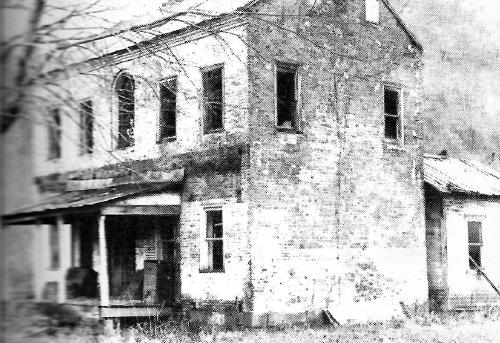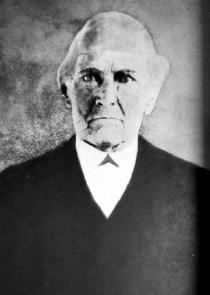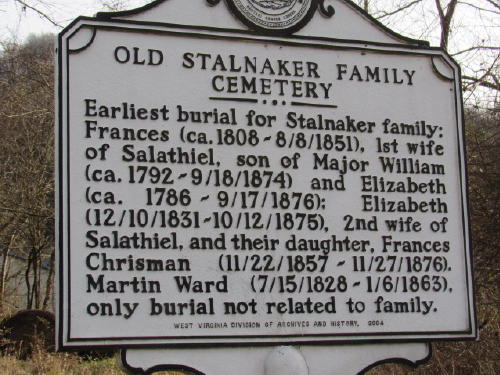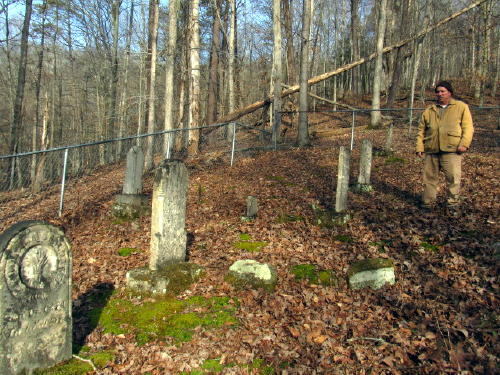1816: MAJOR WILLIAM STALNAKER CREATED GILMER CO. PLANTATION - Built First Brick House, Tobacco Growing Used Slaves

Gilmer's original Stalnaker brick house built on 1000 acre
plantation along the Little Kanawha River after 1816 ...
 ... to become a tobacco plantation near the for-
... to become a tobacco plantation near the for-
mer site of DeKalb at Millseat and Grass Run
By Bob Weaver 2022
Few came to central West Virginia before 1800 except Native Americans and a few explorers, traders and hunters. Gilmer County was unsettled until Jacob Bush came from Lewis County, then called Harrison, to settle as a squatter on Cedar Creek about 1.5 miles from the current U.S. Route 33/119, west of Glenville.
It was six more years before the famous Michael Stump and his sons settled on Steer Creek. In 1810 Peter McCune erected his cabin on the Little Kanawha near the mouth of Leading Creek and became the first settler in DeKalb District, before moving to what would become Calhoun County.
About the same time, several dozen squatters came to settle in the Bear Fork Wilderness of Gilmer, Calhoun and Braxton counties. (Read TALES OF BEAR FORK on HUR HERALD).
Shortly thereafter, Adam Heckert and his family settled at Troy, but it was in 1816 that Major William Stalnaker, who was in the War of 1812, chose a home site near the mouth of Mill Seat Run and Grass Run on the Little Kanawha River, west of Glenville along present day State Route 5.
Millseat Run was site of temporary campgrounds for Native Americans traveling the Little Kanawha River Trail and nearby was the historic Jobs Temple church, established in 1860. The Stalnaker family among the first trustees of the church.
Not far away was the humble Engle Homestead of Henry Everett Engle (1849-1933), where in 1885 he composed "The West Virginia Hills," the state song.
The Stalnaker Plantation was the location of the first "town" in Gilmer County on the Little Kanawha, to become a post office known as DeKalb in 1835.
 Major William Stalnaker (left) moved here with his family from Randolph County in 1816 to claim a land grant, likely 1000 acres, for services rendered in the War of 1812.
Major William Stalnaker (left) moved here with his family from Randolph County in 1816 to claim a land grant, likely 1000 acres, for services rendered in the War of 1812.
Stalnaker's holdings along the river were used for extensive farming and tobacco growing on the plantation, using slave labor and the building of an impressive two-story brick mansion. He first built log cabins for family and slaves. The old brick house had high water marks from over 100 years of flooding.
The "Old Brick" has long vanished from the landscape.


He later built a second brick house for his son Slathiel Stalnaker, a site used for the first meeting of the Gilmer County Court in 1945, a location that was heavily damaged by a flood in 1852 and torn down. The bricks were used several years later for the construction of Calhoun's first courthouse in Grantsville.
The Stalnakers built the first brick kiln in the county. The plantation donated the land for the DeKalb school, among the first in the county.
Cattle and hogs were raised on the steep hillsides with corn and hay being the chief crops.
The large Stalnaker farm was later partially owned by the heirs of the Louis Bennett family, Bennett being the first principal of Glenville Normal School.
The late Bradford Davis of Wilmington, Delaware, recalled many of the events related to the Stalnaker family about 45 years ago, saying "It was a typical southern plantation with the production of tobacco. It was raised, dried and packed into hogsheads and floated down the Little Kanawha on rafts and later barges."
"In 1850 there was a total of 4,961 pounds of tobacco grown in Gilmer, most of it from the Stalnaker plantation. The Stalnakers had about 20 slaves, about one-third of the slaves in Gilmer, emancipated by the Civil War." Several are buried in the nearby Stalnaker Cemetery, perhaps the only cemetery for blacks in the county.
Col. Slathiel Stalnaker, William's son, was one of the commissioners who laid out Gilmer County in 1845 and was its first assessor. He represented Gilmer, Calhoun and Wirt in the state legislature and served four years as Gilmer's County Clerk.
There was controversy when DeKalb was no longer the center of the county, moved to Glenville by "stealth in the night," saying the records could not be found at DeKalb and the County Court was placed at Glenville. Citizens of DeKalb likely exclaimed, "The county seat was stolen."
Bradford Davis recalled early 1900 stories about the nearby old Indian Trail that stretched from Ohio to the Allegheny's that ran through the plantation, once called the "Old River Road." He said there was evidence at the mouth of Millseat Run on the Stalnaker holdings of Native American campgrounds and battlefields, likely fighting over rich hunting grounds.
Two kinds of arrowheads were discovered in the region, long slender and short, along with broader light gray flint, as well as tomahawks and rounded stones for rubbing hides. Also discovered, three oblong mounds of stone marking graves of warriors.
The Old Brick House stood firm during the Civil War. Although there were no real Civil War battles in Gilmer County, according to Davis, renegade bands representing soldiers raided and plundered most sections of the county.

 William Stalnaker (1782-1871) and his wife Elizabeth Goff
William Stalnaker (1782-1871) and his wife Elizabeth GoffStalnaker (1786-1876) are buried on a nearby hillside cemetery

Gilmer County historian William Ostat explores cemetery
Davis describes one incident near the plantation where "soldiers" showed up and demanded to know the hiding place of the horses, while all the men were away. Mrs. Stalnaker would not tell them and they threatened to kill the youngest child. She still would not tell. They took the babe in arms from the woman and placed it in the road, then riding their horses, jumping over it. They rode away, the child unharmed.
Davis said he wrote about a scenic spot near the plantation called "Natural Rock Garden" in an article he wrote in the 1930s called "Have You Even Been To DeKalb?" written in the West Virginia Journal.
He said the "Tree of Heaven" (Ailanthus grandulosa) was introduced from Virginia to the Stalnaker plantation, still a controversial tree.
Members of the Stalnaker clan are buried in a hillside cemetery close to the plantation, likely with a number of slaves associated with the family.
Here in the 21st Century, walking across the Little Kanawha River, Grass Run and Millseat Run, it is almost impossible to visualize the busy plantation from 200 years ago.
An Indian grave near DeKalb is on a high ridge on the right of Holt's Run. It is near the end of the ridge, about one-half mile from Route 35.
The Stalnaker family has continued to proliferate in Gilmer and its regional counties.